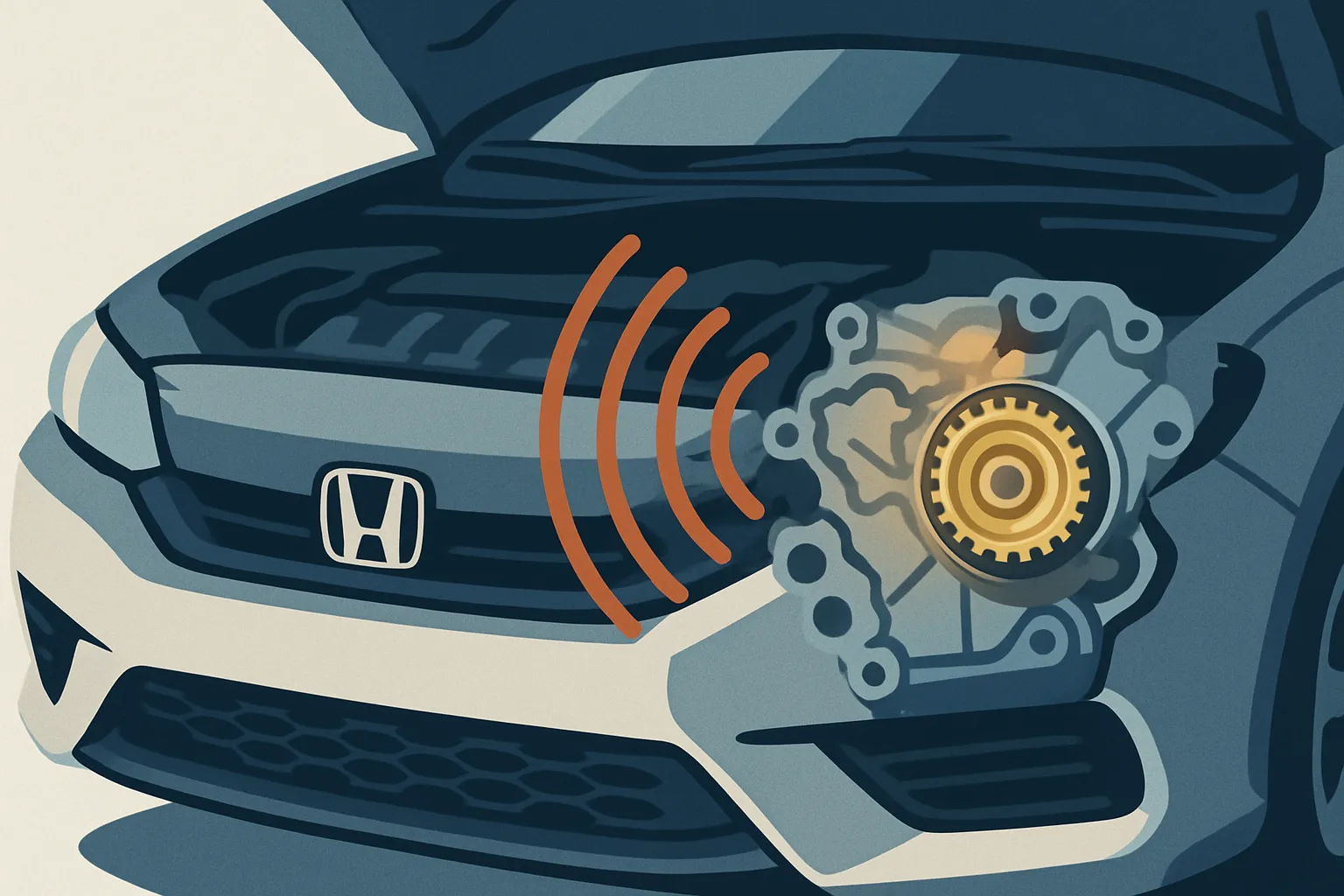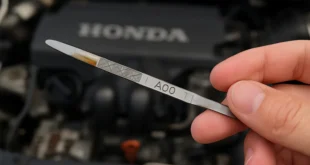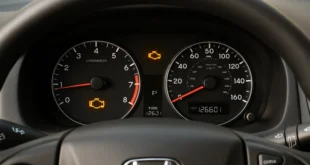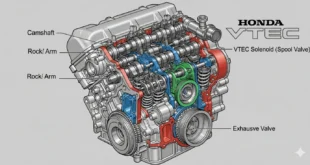Introduction
For many owners of Honda vehicles equipped with the venerable K-series engine (found in popular models like the Civic Si, Accord, CR-V, Element, and Acura counterparts like the TSX), there’s a sound that can be both instantly recognizable and deeply concerning: a brief, metallic rattle or grinding noise that occurs immediately after starting the engine, particularly when it’s cold. This fleeting, 1-2 second noise, often described as sounding like “marbles in a tin can” or a coffee grinder, vanishes as quickly as it appears, leaving the engine running smoothly afterward. Yet, its presence is a common source of anxiety and online forum discussions.
What is this mysterious cold start rattle? More often than not, the culprit is a component called the VTC (Variable Timing Control) actuator. This crucial part of Honda’s sophisticated i-VTEC (intelligent Variable Valve Timing and Lift Electronic Control) system plays a key role in optimizing engine performance, fuel economy, and emissions. However, a specific wear or design issue within the actuator can lead to this characteristic startup noise.
Understanding the VTC system, why the actuator fails in this specific way, what other symptoms might arise, and how to properly diagnose and fix the problem is essential for affected Honda owners. Ignoring the noise might seem tempting since it disappears quickly, but it indicates a component not functioning as intended, potentially impacting long-term engine health and certainly affecting resale value.
This comprehensive guide will explain the function of the Honda VTC system, delve into the mechanics behind the common cold start rattle, outline other potential symptoms of VTC issues, provide diagnostic steps, discuss repair solutions (including important information about updated parts), and offer preventative tips to keep your Honda’s valve timing system operating smoothly.
Understanding the Honda VTC System: The “Intelligence” in i-VTEC
The VTC system is a critical element of Honda’s i-VTEC technology, representing the “Variable Timing Control” aspect. While traditional VTEC systems primarily alter valve lift and duration at high RPMs (as discussed in our VTEC Troubleshooting guide), the VTC system adds another layer of control by continuously adjusting the timing (phasing) of the intake camshaft relative to the crankshaft throughout the engine’s operating range.
Role and Benefits
By advancing or retarding the intake camshaft timing based on engine speed, load, and other factors, the VTC system allows the engine’s computer (ECU) to optimize:
- Low-End Torque: Advancing timing at lower RPMs improves cylinder filling and torque.
- High-End Power: Retarding timing at higher RPMs enhances volumetric efficiency and top-end performance.
- Fuel Economy: Precise timing control optimizes combustion efficiency under various conditions.
- Emissions Control: Helps manage valve overlap to reduce harmful emissions.
Essentially, VTC gives the engine greater flexibility, allowing it to perform efficiently and powerfully across a much broader range of operating conditions compared to engines with fixed cam timing.
Key Components
The VTC system relies on several interconnected parts:
- VTC Actuator (Cam Phaser): This is the core mechanical component, mounted on the end of the intake camshaft. It’s essentially a hydraulically operated gear that can change its rotational position relative to the camshaft itself.
- VTC Oil Control Solenoid Valve (OCV): An electronically controlled valve, commanded by the ECU, that directs pressurized engine oil into specific passages within the VTC actuator to either advance or retard the cam timing. It often has a small filter screen.
- Engine Oil: Absolutely critical. The entire system operates on hydraulic pressure supplied by clean engine oil of the correct viscosity.
- Camshaft Position (CMP) Sensor: Monitors the actual position of the intake camshaft and sends this data back to the ECU.
- Crankshaft Position (CKP) Sensor: Monitors the crankshaft’s position, providing the reference point for cam timing adjustments.
- ECU (Engine Control Unit): The brain of the system. It analyzes inputs (RPM, load, throttle position, sensor data) and commands the VTC Oil Control Solenoid to achieve the desired intake cam phasing.
How the Actuator Works
The VTC actuator contains internal vanes and chambers. The OCV directs oil pressure to specific chambers within the actuator. This pressure pushes against the vanes, causing the outer part of the actuator (driven by the timing chain) to rotate slightly relative to the inner part (bolted to the camshaft). This rotation changes the intake valve timing. A locking pin mechanism is designed to hold the actuator in a default position (often full retard) when oil pressure is absent (i.e., when the engine is off).

Caption: The VTC actuator, mounted on the intake camshaft, uses oil pressure to adjust cam timing.
The Common Problem: Cold Start Rattle/Grind Explained
The notorious startup rattle in many K-series Hondas is almost always linked to the VTC actuator, specifically its internal locking pin mechanism.
Why It Happens: Loss of Oil Pressure and Locking Pin Play
- Oil Drain-Down: When the engine sits for an extended period (especially overnight or longer), oil drains out of the VTC actuator’s internal chambers and passages back into the engine sump.
- Locking Pin Function: The actuator has an internal locking pin designed to engage and hold the actuator’s rotating parts in a fixed default position when there is no oil pressure. This prevents rattling and ensures correct base timing for startup.
- Wear or Design Tolerance: Over time, or potentially due to original design tolerances, the locking pin or the slot it engages with can develop slight wear or excessive clearance. Some theories also suggest the pin can become sluggish due to oil sludge or varnish.
- The Rattle: Upon cold startup, before the oil pump builds sufficient pressure to refill the VTC actuator and hydraulically cushion its internal components, the worn or loose locking pin allows the internal vanes/rotor of the actuator to momentarily oscillate or rattle against the actuator housing due to the forces exerted by the valve train and timing chain. This creates the brief, sharp metallic noise.
- Noise Disappears: As soon as oil pressure builds (typically within 1-2 seconds), the actuator fills with oil, the locking pin’s function becomes less critical (as hydraulic pressure now controls positioning), and the internal components are cushioned, causing the noise to stop abruptly.

Caption: The brief cold start rattle is caused by play in the VTC actuator’s locking pin before oil pressure builds.
Which Engines Are Most Affected?
This cold start rattle is most prevalent in Honda’s K-series 4-cylinder engines, particularly the K20 and K24 variants produced from the early 2000s through the mid-2010s. This includes engines found in:
- Honda Civic Si (2002-2015)
- Honda Accord (4-cyl, 2003-2012, some later models)
- Honda CR-V (2002-2014, some later models)
- Honda Element (2003-2011)
- Acura TSX (2004-2014)
- Acura RSX Type-S (2002-2006)
Note: Specific year ranges can vary, and not all engines within these ranges will develop the issue. Newer Honda engines (like the L-series turbo or updated K-series variants) use different VTC designs that are generally less prone to this specific startup rattle.
Other Symptoms of VTC Actuator/System Issues
While the cold start rattle is the most common actuator-specific symptom, problems within the broader VTC system (including the solenoid or related sensors) can cause other issues:
- Persistent Rattling: If the rattling noise continues beyond the first few seconds of startup or occurs during normal driving, it might indicate a more severe actuator failure or potentially a timing chain issue (tensioner, guides).
- Check Engine Light (CEL): The ECU monitors VTC operation. If the actual cam phasing (measured by the CMP sensor) doesn’t match the commanded phasing, or if the system is stuck or slow to respond, it can trigger CEL codes. Common VTC-related codes include:
- P0010: VTC Oil Control Solenoid Valve Circuit Malfunction
- P0011: Intake Camshaft Position Timing Over-Advanced or System Performance
- P0341: Camshaft Position Sensor Circuit Range/Performance (often indicates a correlation issue between cam and crank signals, potentially VTC-related)
- Rough Idle or Stalling: If the VTC actuator gets stuck in an advanced or retarded position, it can cause unstable idle or stalling, as the cam timing is incorrect for low-speed operation.
- Reduced Engine Performance/Fuel Economy: An improperly functioning VTC system prevents the engine from optimizing cam timing, leading to noticeable power loss (especially at certain RPMs) and decreased fuel efficiency.
- Hesitation or Drivability Issues: Inconsistent VTC operation can cause hesitation during acceleration or other drivability problems.
It’s important to note that symptoms like CEL codes, rough running, or performance loss are often related to the VTC Oil Control Solenoid or sensor issues, rather than the internal actuator wear that causes the startup rattle.
Diagnosing VTC Actuator Problems
Diagnosing VTC issues involves differentiating between the common startup rattle (usually the actuator itself) and other VTC system malfunctions.
1. Confirming the Cold Start Rattle:
– Listen Carefully: Pay attention to the exact timing and duration of the noise. Does it happen only on cold starts and last only 1-2 seconds?
– Record the Noise: Capturing an audio or video recording can be very helpful for confirming the sound with online examples or showing it to a mechanic.
– Note Conditions: Keep track of when it occurs (engine temperature, ambient temperature, how long the car sat).
2. Scan for OBD-II Codes:
– Even if the CEL isn’t constantly on, check for stored or pending codes using an OBD-II scanner. VTC-related codes (P0010, P0011, P0341) point towards a system malfunction needing further investigation beyond just the startup rattle. Our Check Engine Light guide can help decode these.
3. Inspect the VTC Oil Control Solenoid Valve (OCV):
– Location: Usually found on the cylinder head near the VTC actuator.
– Filter Screen: Remove the OCV (typically held by one bolt). Inspect the small mesh filter screen(s) at its base. Clean gently with brake cleaner if clogged with debris or sludge. A clogged screen can impede oil flow and cause performance issues or codes (but usually not the startup rattle).
– Electrical Test: Check the solenoid’s resistance with a multimeter and compare to specifications. Apply 12V (briefly, check service manual for polarity) to listen for an audible click, indicating the solenoid is actuating.
4. Check Engine Oil:
– Level and Condition: Low oil level or severely degraded/dirty oil can starve the VTC system of necessary pressure, potentially worsening the rattle or causing other operational issues. Ensure oil is clean, full, and of the correct viscosity (usually 5W-20 or 0W-30 for most K-series). Excessive Oil Consumption can lead to low levels.
5. Professional Diagnosis (If symptoms beyond startup rattle exist):
– Live Data Monitoring: A mechanic with an advanced scan tool can monitor the commanded vs. actual intake camshaft phasing angles in real-time. Deviations indicate a problem with the actuator, solenoid, or oil pressure supply.
– Timing Chain Inspection: Persistent rattling, timing correlation codes (P0341), or high mileage might warrant checking the timing chain stretch and the condition of the tensioner and guides. A stretched chain or failing tensioner can sometimes mimic VTC issues or occur concurrently.
– Oil Pressure Test: Verify that engine oil pressure meets specifications, especially at idle and higher RPMs.
For the isolated cold start rattle with no other symptoms or codes, the diagnosis is almost always a failing VTC actuator.
Repair Solutions: Fixing the Rattle and Other Issues
1. VTC Actuator Replacement (Fix for Cold Start Rattle):
– The Definitive Fix: Replacing the VTC actuator assembly on the intake camshaft is the standard and generally accepted repair for the characteristic 1-2 second cold start rattle.
– Use Updated OEM Part: Honda has released revised/updated versions of the VTC actuator for many affected K-series engines over the years, designed to mitigate the locking pin wear/clearance issue. It is crucial to use the latest Honda Genuine OEM part number specified for your vehicle’s VIN. Using aftermarket actuators or older OEM versions may result in the noise returning prematurely.
– Repair Process: This is a moderately complex job.
– Requires removal of the valve cover.
– Requires removal of the camshaft position sensor pulse plate.
– Requires careful removal and installation of the actuator itself, potentially requiring temporary removal or securing of the timing chain.
– Timing must be set correctly during reassembly.
– Cost: This repair can be relatively expensive due to the labor involved. Expect costs ranging from $500 to $1000+ at a dealership or independent shop, depending on local labor rates and the specific model. The part itself typically costs $100-$200.
– Solenoid Note: Replacing only the VTC Oil Control Solenoid will not fix the cold start rattle caused by the actuator’s internal locking pin.
2. VTC Oil Control Solenoid Valve (OCV) Replacement/Cleaning:
– Addresses: CEL codes (P0010, P0011), performance issues, rough idle, or hesitation related to incorrect VTC operation (but not the startup rattle).
– Procedure: Relatively simple replacement or cleaning of the filter screen.
– Cost: Solenoid part cost is typically $50-$150. Labor is usually minimal (0.5-1.0 hours).
3. Timing Chain and Related Components Service:
– Addresses: Persistent rattling beyond startup, timing correlation codes, diagnosed chain stretch or tensioner failure.
– Procedure: A major repair involving removal of the timing chain cover, replacement of the chain, tensioner, guides, and potentially sprockets.
– Cost: Significant, often $1000-$2000+.
DIY vs. Professional Repair: A Word of Caution
- VTC Actuator Replacement: While technically possible for a skilled DIYer with the right tools (including torque wrenches, potentially timing chain tools), this repair carries a high risk if done incorrectly. Mistakes during reassembly, especially concerning timing chain alignment, can lead to severe engine damage (bent valves). Professional installation is generally recommended unless you have significant experience with engine timing components. Compare costs with our DIY vs Dealer guide.
- VTC Oil Control Solenoid: This is much more accessible and DIY-friendly for most owners with basic tools.
Preventative Measures and Long-Term Care
While the actuator failure might be partly due to design, good maintenance practices are crucial for the overall health of the VTC system:
- Consistent Oil Changes: This is the single most important factor. Use high-quality synthetic oil meeting Honda specifications (API certified, correct viscosity like 0W-20, 5W-20, or 5W-30 as per manual). Clean oil ensures proper hydraulic pressure and minimizes sludge buildup that could affect the actuator or OCV screen.
- Correct Oil Viscosity: Using oil that is too thick can impede flow, especially when cold. Stick to the manufacturer’s recommendation.
- Quality Oil Filter: Use a good quality oil filter (OEM Honda filters are generally recommended) to effectively remove contaminants.
- Engine Warm-Up: Allow the engine a brief moment (30-60 seconds) to build oil pressure before driving off, especially in cold weather. Avoid aggressive driving until the engine is fully warmed up.
- Address Oil Consumption: If your engine consumes excessive oil, address the root cause, as low oil levels can starve the VTC system.
Conclusion: Silencing the Rattle
The Honda VTC actuator cold start rattle is a common, well-documented issue primarily affecting K-series engines. While alarming, the noise itself is usually benign in the short term, indicating wear in the actuator’s locking pin mechanism. However, it’s a sign that a component isn’t operating perfectly and should ideally be addressed, especially if you plan to keep the vehicle long-term or are concerned about resale value.
The definitive fix is replacing the VTC actuator with the latest updated OEM part. Other VTC system issues causing performance problems or CEL codes often point to the oil control solenoid or oil quality/level. Due to the complexity and risks involved in replacing the actuator, professional repair is generally advised. By understanding the cause of the rattle and prioritizing regular, high-quality oil changes, you can effectively manage or resolve VTC issues and keep your Honda’s i-VTEC system performing as intended.



